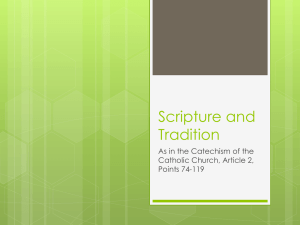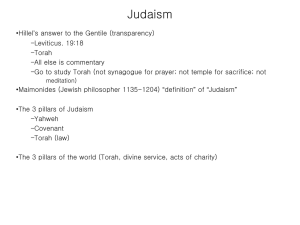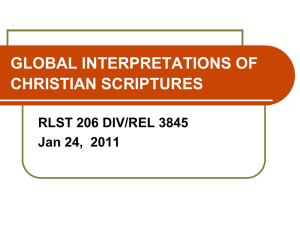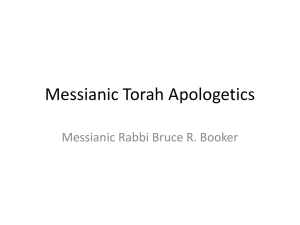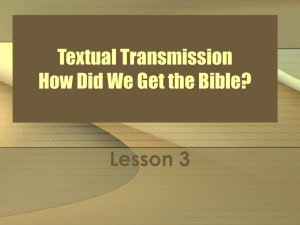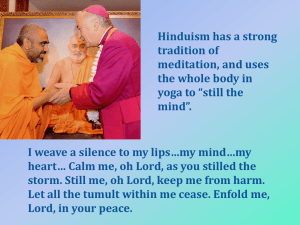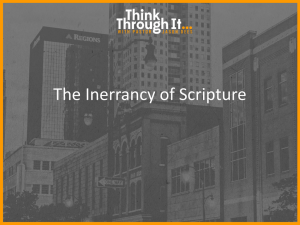GLOBAL INTERPRETATIONS OF CHRISTIAN SCRIPTURES
advertisement
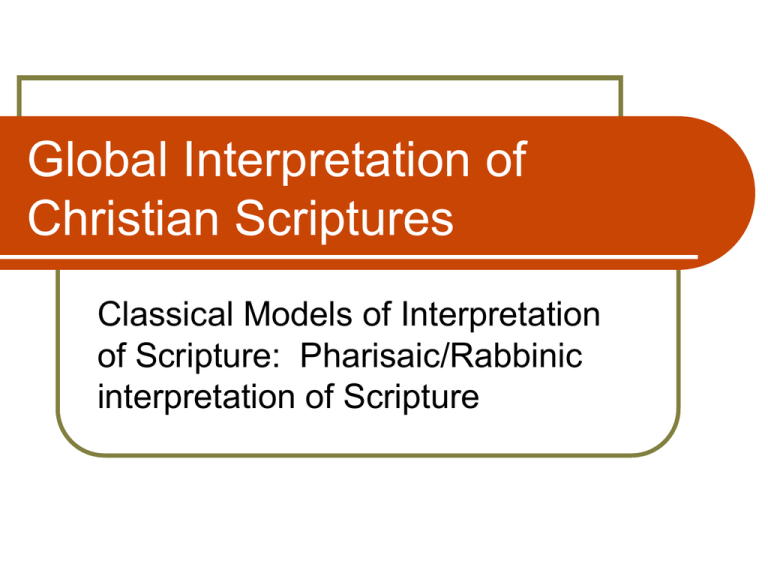
Global Interpretation of Christian Scriptures Classical Models of Interpretation of Scripture: Pharisaic/Rabbinic interpretation of Scripture COVENANT as Jewish Hermeneutical-Theological Frame 1. 2. DP’s Early Jewish Hermeneutics, 1975. Pharisees (Rabbinic Judaism in formation) Apocalyptic groups (Zealots, Qumran) Sadducees Shared Basic Conviction: We are the Chosen People of God . . . Shared Basic questions/concerns: How to remain the Chosen People? How to be the Chosen People? Why? Jewish Interpretations of Scriptures EARLY RABBINIC/PHARISEES VIEW OF SCRIPTURE Interpret Scripture = Tanakh = Torah Prophets/Nebiim Writings/Ketoubim Explicit views of Scripture = Torah « defile the hands” = sacred text; what is read; the writings Early Rabbinic/Pharisees: Explicit Views Of Scripture Why is Scripture sacred? Torah is the complete, final, immutable revelation : “everything is revealed on Mount Sinai” in the world to come God teaches Torah. = Wisdom (Prov 8:22ff) with God at the creation; blueprint of creation = God’s Wisdom. More than the written text. = before and beyond the written text. Given to Israel = God giving himself to Israel Early Rabbinic/Pharisees: Explicit Views Of Scripture to recite or read Torah = being in the Presence Shekinah [G’D] “where two or three are gathered and exchange words of Torah the Shekinah is with them. thus Torah = surrogate of the Temple taking the yoke of Torah = taking the yoke of Heaven [G’D] Torah = water (gratis, priceless, brings life) wine; fire, wife Early Rabbinic/Pharisees View Of Scripture (1) IN SYNAGOGUE and IN SCHOOL In Synagogue Cycle of readings; Torah (seder) prophets (haftarah) (verbal tallying) Translation = Targum Homilies; stringing texts together (pearls)… a text, interpreting another text, interpreting another text…. Back to the first text. (eventually written down = Midrash) Targum = same thing as homilies… explain the text, in terms of other texts. Early Rabbinic/Pharisees: Synagogue (2) Haggadic interpretations Some Hermeneutical principles: 1) Everything is meaningful in Scripture; 2) Scripture is to be explained by Scripture; 3) Synthetic view of scripture and of sacred history/ “telescoping” “ There is no before and after in scripture” (one of 32 middoth rules): ex: nights of creation, of Abraham (covenant, Gen 15), of Aqedah (sacrifice of Isaac), of Passover, eschatological night of Messiah = sacred history is closed: God acted/revealed in the past, the sacred past of sacred history; will act/reveal in the future; in between there is no new revelation Everything is revealed on Mt Sinai Early Rabbinic/Pharisees: Synagogue (2) Haggadic interpretations Some Hermeneutical principles (continued): 4) Theological developments in Targum =not systematic theology = haggadah = (sacred) stories = a listening to scripture 5) Some actualization of scripture = circle of scripture interpreting scripture is broken – but primarily halakic (back to this later) Early Rabbinic/Pharisees: Synagogue (4) Liturgical Haggadah All liturgy = scripture = participating in liturgy (prayers, songs, readings, translations/targums, homilies) = entering Scripture Entering Torah = being constituted as the people of God = example of Passover Seder = we went out of Egypt We are the people of Israel described in Scripture Early Rabbinic/Pharisees: Covenant Covenant: a) God’s intervention, redemption from slavery = election;= haggadah (past) b) Vocation: people of priest for the nations; haggadah = sanctification of the Name C) Law = how to walk: halakah Early Rabbinic/Pharisees: School: Halakah Sanctification of the Name Oral Torah = living tradition= harmonize Torah and life Beyond the written Biblical Text (as Torah was with God, before the creation) Gezeroth = teaching independent from Scripture Takkanoth = teaching radically changing the teaching of Torah = Prosbul of Hillel Sanctification of the Name Early Rabbinic/Pharisees: School: Halakah Sanctification of the Name Making a fence around Torah Always changing and growing tradition: Mishnah, Talmud; reinterpreted in terms of the new situations in life; Here Revelation, Scripture = open; on going; discerning what is God’s will = how to sanctify the name today Being faithful = adapting, changing… COVENANT (Exodus 19 & 20) as Hermeneutical/Theological Frame: For Pharisees and Rabbis: Election (as the Chosen People of God) = God’s freeing the People from bondage = saved from bondage = done; closed revelation Vocation (to be a people of priests = Sanctification of the Name) closed revelation Law = Way to walk… How to fulfill this vocation (to sanctify the Name) open = always new ways for new contexts (inculturation) Exodus 19:3-6 3 "Thus you shall say to the house of Jacob, and tell the Israelites: 4 You have seen what I did to the Egyptians, and how I bore you on eagles' wings and brought you to myself. 5 Now therefore, if you obey my voice and keep my covenant, you shall be my treasured possession out of all the peoples. Indeed, the whole earth is mine, 6 but you shall be for me a priestly kingdom and a holy nation. These are the words that you shall speak to the Israelites." Exodus 20:1-4 1 Then God spoke all these words: 2 I am the LORD your God, who brought you out of the land of Egypt, out of the house of slavery; 3 you shall have no other gods before me. 4 You shall not make for yourself an idol, Pharisees (DP’s Early Jewish Hermeneutics, 1975) Pharisees = One Covenant Election: complete = everything has been revealed on Mount Sinai (Oral and Written Torah) Haggadah: Closed sacred history Liturgy; interpreting Scripture by Scripture (Midrash) Halakah: needs to be reinterpreted again and again (Mishnah, Talmud, constantly interpreted in terms of social, cultural situation) Apocalyptic people: e.g. Qumran (DP’s Early Jewish Hermeneutics, 1975) Apocalyptic = New Covenant (people still in bondage) Election: God is electing, choosing a remnant/a new faithful people = new interventions of God Typology; Prophecy are fulfilled Haggadah = Open sacred history, ongoing activity of God , establishing and reestablishing the covenant through choosing/calling a new people, through interventions of power Halakah = Very strict; AS BY PRIEST IN THE TEMPLE Pharisees = One Covenant People freed from bondage Election: complete = everything has been revealed on Mount Sinai (Oral and Written Torah) Haggadah: Closed sacred history Liturgy; interpreting Scripture by Scripture (Midrash) Halakah: needs to be reinterpreted again and again (Mishnah, Talmud, constantly interpreted in terms of social, cultural situation) Apocalyptic = New Covenant People still in bondage) Election: God is electing, choosing a remnant/a new faithful people = new interventions of God Typology; Prophecy are fulfilled Haggadah = Open sacred history, ongoing activity of God , establishing and reestablishing the covenant through choosing/calling a new people, through interventions of power Halakah = Very strict; AS BY PRIEST IN THE TEMPLE
